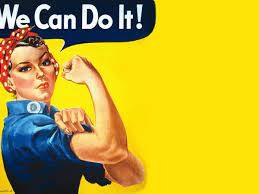Rosie the Riveter:
Rosie the Riveter is a media icon who was associated with female defense workers at the time of World War II. Since the 1940s, Rosie the Riveter has risen as a symbol for women in the women’s independence and workforce. At the beginning of the year 1942, as a large number of American men were recruited for the war purpose, women were required to fill their positions in factories. Initially, women workers were chosen from among the working class, but, as the war production needed to be increased, it became necessary to recruit workers from among middle-class women also.

Since many of these female workers had not previously worked away from the home and children, the government had to convince them to enter the workforce
and also had to provide ways for the women to care for their children and household. To accomplish this task, the U.S. Office of the War generated a variety of materials created to convince the women to work in war production jobs as part of their patriotic duty toward their Nation. Rosie the Riveter, which was a part of this propaganda campaign, became a popular symbol of
women in the workforce at the time of World War II.
It is believed that this initial drawing of Rosie the Riveter was part of the
Westinghouse Electric Corporation during the time of war production campaign to choose female workers.
Miller’s drawing portrayed a woman in a red bandana with her bent arm flexed, rolling up her shirtsleeve.
Also read:
How many people died in World War II?